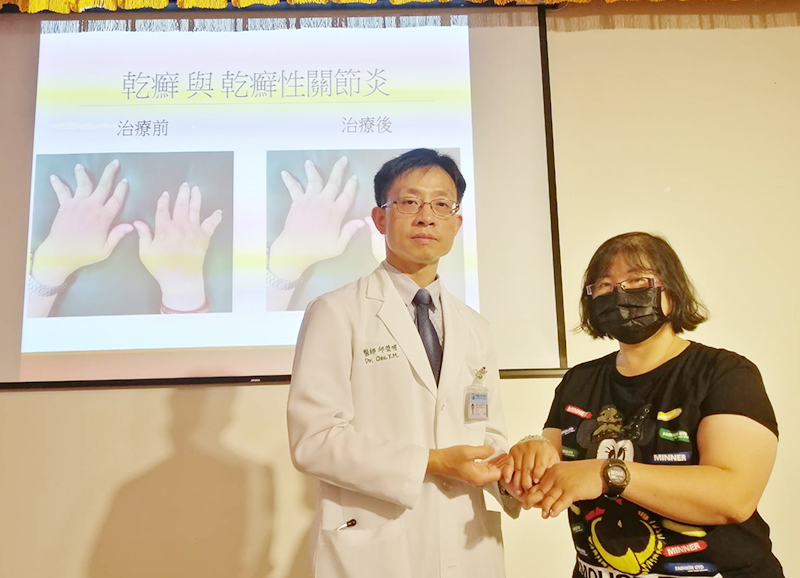News and Award
About CMUH
Be careful! Poor psoriasis control can also lead to deformed joints

Disease Management and Data Science Research Room of Center of Rheumatology and Immunology Director Ying-Ming Chiu
Miss Lu, 41 years old, was diagnosed with psoriasis at her senior year in college, which symptoms included large area of rash and constant scaling on the limbs and body. Miss Liu was forced to wear long pants and long-sleeve shirts even during such warm days with high temperature in order to avoid drawing peculiar look from other people. After 2-3 years, Miss Liu started to have arthritis on her hand but she was unaware that psoriasis could also be complicated with psoriatic arthritis and though it as a result of injury. She did not receive immunity related treatment and hence the joints of her hand eventually deform. After years of visiting the department of rheumatology and immunology, the joints of her hands were severely deformed and even the immune treatment then could not recover the deformed joints. Currently such deformed joints could experience severe pain when slightly touched while it is difficult for the fingers to rotate. For example, the patients could not open caned drinks when they are thirsty because they need help from other people. They could not button up the clothes or turn the handle when riding scooters. Hence, Miss Liu is quite upset and regretting for not having correct treatment early when the joint ache started at the first place.
Psoriatic arthritis is one type of inflammatory arthritis related to psoriasis and also one autoimmune disease. The immune system of patients will attack the normal tissues of its body once there is a problem with the immune system, resulting in skin psoriasis and arthritis. The incidence of most patients take place between the age of 30 something to 50 something, where the ratio between male and female patients is close to 1:1
What are the symptoms of psoriatic arthritis?
Psoriatic arthritis can occur in any joint of the body, particularly with incidence on the joints of fingers or toes. Sometimes psoriatic arthritis can cause severe the entire finger or toe to swell like sausage, commonly known as sausage finger (toe). Some patients could have so-called enthesopathy, namely inflammation on the connection between the tendon and bones on the bottom of the feet and heels. Moreover, chronic neck, waist and lower-back pain and morning stiffness could also take place, which phenomenon occurs because there is also inflammation on the spinal column. Clinically, except for the aforementioned symptoms of joints, psoriatic arthritis also shows different symptoms on the skin, nail and eyes.
How to diagnose psoriatic arthritis?
The history of psoriasis on the skin is the main source of diagnosis when the doctors are diagnosing psoriatic arthritis, which is also one major characteristics for distinguishing psoriatic arthritis from other arthritis. Currently there is no single blood drawing test that could be adopted for diagnosing psoriatic arthritis. Skin biopsy may be required to help diagnosing psoriasis if the skin lesions of patients are non-typical from outside. Moreover, x-ray can be applied as reference for diagnosing psoriatic arthritis.
How can psoriatic arthritis be treated?
The medical treatment for psoriatic arthritis includes anti-inflammatory drugs and painkillers, immune modulators and biological agents. Immune modulators can reduce the likelihood of deformed joints but the time for the treatment effect to take place is slower, which then needs to be taken with anti-inflammatory drugs. Biological agents work well on psoriatic arthritis and psoriasis and is currently covered by the National Health Insurance. However the price for such medicine is very expensive, the National Health Insurance thus requires the use of the medicine on critical patients who could not be treated by traditional treatment.




![[Taiwan–Malaysia Medical Innovation Forum] CMUH and UNIMAS Co-Host Major Medical Symposium to Advance Medical Technology and Precision Patient Care img](/FileUploads/News/20250714_131324.jpg?w=250&h=180&mode=crop&scale=both)